Canon EOS 450D / Digital Rebel XSi
-
-
Written by Gordon Laing
Canon EOS 450D / Rebel XSi design and controls
Measuring 129x98x62mm, the Canon EOS 450D / XSi is 2mm wider, 4mm taller and 2mm deeper than its predecessor, but place them side by side and the new model looks smarter with a curvier head and sloping shoulders – it’s a personal choice, but to our eyes, the new model looks more professional. We’ve pictured the Canon EOS 450D / XSi below on the left alongside the earlier EOS 400D / XTi.
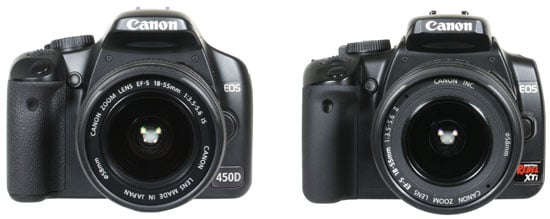 |
The build quality is roughly the same as the 400D / XTi, although a new textured finish around the grip and thumb rest gives it a classier feel that’s closer to the higher-end Canon DSLRs. In terms of weight, the new 450D / XSi actually comes in slightly lighter than its predecessor when both are fitted with their respective batteries and kit lenses. Indeed it’s surprisingly light when you pick it up, which will please anyone who values portability, but equally alienate those who are reassured by something more substantial.
The 450D / XSi’s biggest rival is likely to be the Sony Alpha DSLR-A350. The build quality of both cameras is again roughly similar, although the Sony’s several mm bigger in every dimension and feels noticeably heavier too – the body-alone specs show 100g of difference, but fit their respective batteries and kit lenses and this difference almost doubles. To see how both cameras look side-by-side, see our Sony Alpha DSLR A350 review.
 |
Much of the A350’s extra size and weight is down to the Sony’s built-in stabilisation, tilting monitor and relatively hefty battery, along with a thicker grip that’s better-suited to bigger hands. Viewed from above, the Canon looks like there’s only a modest gap between its grip and the lens barrel, but like its predecessor, the grip thins below the shutter release to leave plenty of room for your finger tips – although this in turn makes it grip feel a bit skinny unless you have small hands. As always, the look and feel of a camera is highly personal, so we’d recommend checking them out in person.
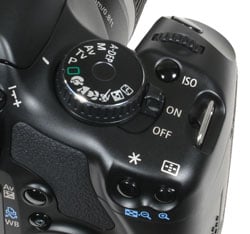 |
In terms of controls, the 450D / XSi is very similar to its predecessor with only a handful of tweaks. The upper left side is again left bare, with the bulk of the controls located on the right side of the body. Starting on the upper right surface, there’s the main Command Dial with the same modes as the 400D / XTi: the usual P, A, S and M modes, along with direct access to six scene presets, Canon’s A-DEP mode and a fully Automatic ‘green square’ option.
The Scene presets consist of Portrait, Landscape, Close-up, Sports, Night Portrait and Flash Off. The A-DEP mode automatically controls the depth of field to ensure all subjects covered by the AF points are in focus (where possible). The 450D / XSi offers shutter speeds from 30 seconds to 1/4000 along with a Bulb option; the fastest flash sync speed is 1/200 and we have more details about the flash below.
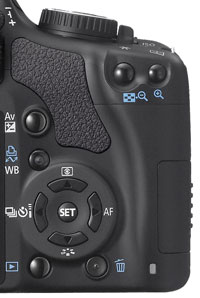 |
As before, the power switch is fitted around the Command Dial, although the grips on both have been subtly redesigned. The green power light of the 400D / XTi has also gone, replaced by a decent-sized button dedicated to adjusting the ISO sensitivity. In front of this, the finger dial and shutter release remain and feel pretty much the same as before, although the scooped indented area around the 450D / XSi’s shutter release now extends to the edge of the grip. The AE / AF lock and AF point selection buttons remain in the top right corner of the rear and as before double-up as zoom controls during playback – along with AF and manual focus assist controls in Live View.
Round the back of the camera, the larger 3in screen is the biggest difference between the 450D / XSi and its predecessor, and it’s forced a relocation of some controls. The five buttons which used to run vertically down the left side of the 400D / XTi’s screen are now gone. The Menu and Disp buttons are now above the screen to the left of the viewfinder, while the Play and Trash buttons can be found below the cross-keys; the Jump button is now gone, but we don’t believe many would miss it.
The exposure compensation button has grown but remains to the top right of the screen, although what used to be the drive button below it has now become a combined Direct Print / White Balance control. With White Balance and sensitivity removed from the cross-keys, the four buttons now offer dedicated control over the drive mode, metering, AF mode and Picture Style.
The SET button in the middle of the cross-keys now has white text to reveal its upgraded importance as both a programmable function key and the control which toggles Live View. Finally, the card activity light has moved from the bottom left corner of the screen to just below the card door’s hinge.
A final point worth noting is Canon has kept the depth-of-field preview button which can be found just below the 450D / XSi’s lens release button. While depth-of-field previews may only be used by a limited number of photographers, it’s a shame to see them missing on many newer DSLRs like the Sony Alpha A350. It’s a relief to find the facility remaining on Canon’s entry-level models.
| ||
Canon EOS 450D / Rebel XSi flash
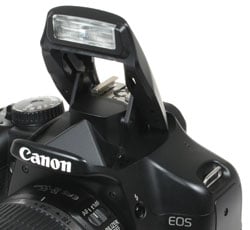 |
The EOS 450D / XSi is equipped with an internal flash with a guide number of 13 which pops-up 55mm above the top of the lens mount, compared to the relatively short 38mm of the flash on the Sony Alpha A350 – this is due to the shorter hinge distance on the Sony, required to accommodate its Live View sensor in the viewfinder head. The higher flash on the Canon allows it to better avoid red-eye and shadows cast from physically larger lenses.
On top of the 450D / XSi’s head you’ll find a hotshoe for an optional flashgun (now bare silver compared to the black contacts of its predecessor, but lacking the weather protection of the 40D), and as you’d expect for its price point, there’s no PC sync port for studio lighting – for that you’d need the EOS 40D. The 450D / XSi’s flash sync speed is 1/200.
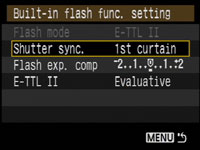 |
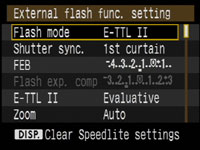 |
The 450D / XSi features a dedicated page of options for the internal flash which allow you to set the curtain sync, compensation and E-TTL II mode. Impressively like the semi-pro 40D, you also now get direct in-camera control over the functions of compatible Speedlites like the 580 EX II, allowing you to adjust the compensation, bracketing, sync and zoom modes without touching the flash.
Canon EOS 450D / Rebel XSi viewfinder
The EOS 450D / XSi is equipped with an optical viewfinder which employs a penta-mirror arrangement and offers 95% coverage with 0.87x magnification. This is an improvement over both the 0.8x of the 400D / XTi, and the relatively modest 0.74x of the Sony Alpha A350. The latter is again due to the Live View sensor located in the A350’s viewfinder chamber.
| ||||||||||
In practice, the 450D / XSi’s viewfinder appears noticeably bigger than that of the Sony A350, and arguably a little brighter too. Compared to the earlier 400D / XTi though, the difference is more subtle. The 450D / XSi’s viewfinder is definitely a little bigger than its predecessor, but we’re not talking a huge difference. Either way, any improvement here is welcomed.
The Sony A350 viewfinder does have one neat advantage over the 450D / XSi though: when you switch the A350 into Live View mode, a shutter curtain automatically closes in the viewfinder to prevent any stray light from entering. Canon also has protection against stray light, but it involves first removing the rubber surround from the viewfinder before then inserting the plastic cover that’s fitted onto the strap – hardly as slick.
In terms of markings, the 450D / XSi’s viewfinder shows the same nine focusing points as its predecessor, although the centre-point is now circled to indicate the spot-metering area that’s new to this model over the 400D / XTi.
As you’d expect for a camera at this price point, you can’t swap the focusing screen, and unlike Nikon’s D80 upwards, there are no on-demand LCD grid lines. However in a very welcome move, the 450D / XSi inherits another feature from the higher-end EOS 40D: the ISO sensitivity value displayed in the viewfinder at all times. Annoyingly, this is something which still isn’t shown in the vast majority of entry-level DSLRs, including the Alpha A350, unless you’re holding the ISO button at the time. So thank you Canon, that’s a much appreciated feature.
Canon EOS 450D / Rebel XSi Screen and Live View
The Canon EOS 450D / XSi is equipped with a 3in screen that’s half an inch bigger than its predecessor and the Sony A350. This extra half inch makes a big difference to the overall surface area, with the 450D / XSi’s monitor dominating its rear surface. The resolution remains 230k pixels, but the screen looks very bright and vibrant in use.
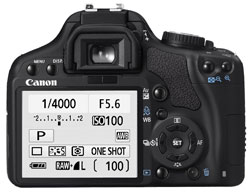 |
The 450D / XSi’s screen may be a decent size and quality, but it’s fixed in position, unlike the Sony Alpha A350’s screen which can tilt vertically. This makes the Sony much easier to compose in Live View at high or low angles and is a key advantage of the A350 over the 450D / XSi.
Live View is a new feature for the 450D / XSi and a key differentiator over its predecessor. The basic implementation is similar to the higher-end EOS 40D, and that includes switching it on in the first place. Unlike rival models which sensibly feature a dedicated Live View button or switch, there’s nothing obvious for activating it on the 450D / XSi.
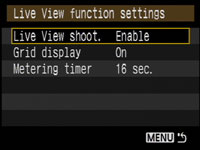 |
Indeed like the EOS 40D, Live View isn’t even enabled as standard, so you’ll need to enter a menu to do so, after which pressing the SET button on the back of the camera will activate it. It’s almost as if Canon’s a bit embarrassed about the feature, hiding it from conservative users who still disapprove and hoping those who are interested will seek it out.
Once the feature is enabled and the SET button pressed though, the system works as expected: the mirror flips up to expose the main sensor and the live image displayed on-screen about 1.5 seconds later.
Like the EOS 40D, a custom function allows you to enable a three-by-three grid to help with alignment or applying the rule of thirds. Pressing the Disp button also cycles between a clean view, further shooting information, and a Live Histogram – it’s worth remembering the high-end Nikon D300 doesn’t even offer the latter.
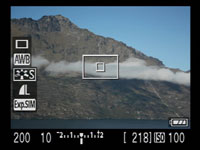 |
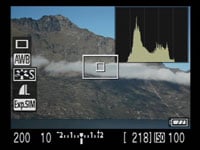 |
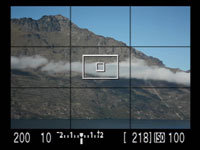 |
Since the main sensor is used to deliver Live View, what you see is what you’ll get. The 450D / XSi Live View shows 100% coverage and you can use the AF-point selection button to zoom-in by five or ten times for precision manual focus assistance; this magnified area can also be moved around the frame using the cross-keys. This feature is highly valued by technical photographers such as those doing macro or astro-photography, and if you’re still not convinced, you can see a demonstration of how useful it is in our 450D / XSi video tour, along with our video demonstration of astro-photography on the EOS 40D.
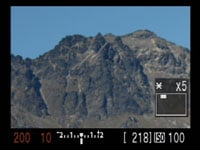 |
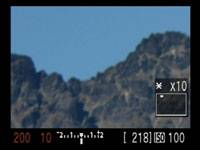 |
In terms of auto focusing in Live View, you have two choices with the 450D / XSi. First is the traditional phase-change system used outside of Live View, and which Canon calls ‘Quick mode’. This temporarily drops the mirror to take a reading, before flipping it back up again to continue the Live View.
To do this you’ll need to set Custom Function 8 to Quick Mode, after which you can use the AF / AE lock button to perform the autofocus process. As you press and hold the button, the mirror drops and the lens focuses, although the Live View won’t return until you let go of the button. If the lens locks onto the subject quickly and you let go as soon as the focus is confirmed, the entire process can be done in about one second.
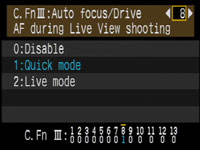 |
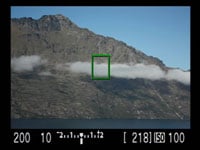 |
The second AF choice is called ‘Live Mode’ and is new to the 450D / XSi over the EOS 40D. It uses a contrast-based system like a compact camera to autofocus in silence without dropping the mirror or interrupting the view. You can also use the cross-keys to move the single focus point to anywhere on the image.
The downside is speed, with the process taking place much more slowly – typically three seconds even with an easy subject under bright conditions. On the upside though, unlike the contrast-based AF on the Panasonic L10 and Olympus E-420, you can do it with any Canon lens and there’s no firmware updates necessary. We verified this with a number of Canon lenses, although were unable to try it with third-party models.
In use the 450D / XSi’s Live View worked similarly to other systems which use their main sensor. The conventional Quick View mode was preferred for speed, even if there was the sound of the mirror flipping. The contrast-based Live Mode was frustratingly slow at times, but may be preferred for its silence and lack of image interruption. The image itself during Live View was bright and quickly refreshed, although the fixed screen understandably became harder to see at high or low angles.
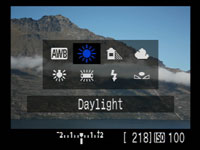 |
You can however preview the depth-of-field, with the camera increasing the screen brightness to compensate, and this works really well in conjunction with the magnified focus assistance, to ensure there’ll be no unpleasant surprises. The effect of Image Stabilised lenses could also be seen on-screen with a half-press of the shutter release. Unlike the Sony A350, you won’t see a preview of the White Balance as you run through the options, but once they’re selected, you’ll see the effect on-screen.
Compared to the Sony A350 in operation though, the Canon 450D / XSi’s Live View feels slow, loud and almost clunky. The Sony system activates quietly at the flick of a switch, auto-focuses without delay, while the tilting monitor allows you to more easily compose at high or low angles. It is without a doubt the preferred system for anyone who wants a point and shoot experience with a DSLR.
But by using its main sensor, the 450D / XSi Live View boasts 100% coverage, magnified manual focus assistance, superimposed alignment graphics and a preview of Image Stabilised lenses – you won’t get any of that with the A350. Unlike the Sony system, there’s also no compromise of the optical viewfinder nor the height of the popup flash. A crucial advantage for the Canon is that it’s also supplied with software which allows you to remote control the camera with your computer, including seeing the live video feed on your monitor and the ability to not just trigger the shutter but also focus the lens from afar – see Features page for more details.
So it’s a swings and roundabouts situation and you’ll need to carefully weigh-up the options. Ultimately the 450D / XSi’s Live View may not be as quick or fuss-free as the Sony, but it will undoubtedly appeal more to technical photographers such as those using Live View in tripod-based environments.
Canon EOS 450D / Rebel XSi menus
Like most DSLRs these days, the EOS 450D / XSi uses its main colour screen to display shooting information, and like its predecessor, there’s proximity detectors to switch it off when you’re composing your shot with the optical viewfinder. You can choose from one of four colour schemes, including white characters on a black background which is ideal for very low light or dark environments.
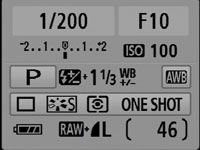 |
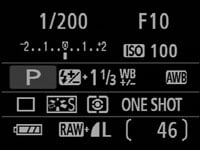 |
Pretty much the same shooting information is shown as before, although Canon’s chosen to redesign the presentation. From left to right, top to bottom, you’ll see the shutter speed and aperture, exposure compensation scale and ISO sensitivity, shooting mode, flash compensation value, bracketing options and white balance, drive mode, Picture Style, metering and AF modes, battery life, image quality and shots remaining. Owners of the 400D / XTi will notice the focus point selection is no longer shown at all times, although you do now get to see the Picture Style in use.
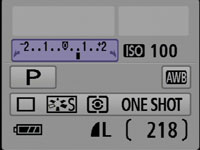 |
Most of the items have dedicated buttons which fire-up separate menus to select the options. The exceptions are the shutter, aperture and exposure compensation which are adjusted directly from this main screen, with curved arrows on either side of their values indicating the finger dial’s operation.
Unlike Sony’s presentation, there’s no optional reformatting of the information with bigger or smaller fonts, nor the rotating characters which remain upright even when you’re shooting in portrait orientation with the camera on its side. Since Nikon now offers the latter on the D60, we were hoping to also find it here.
Press the Menu button and you’ll see a similar tabbed presentation to the higher-end EOS 40D, albeit with fewer pages: the 450D / XSi has seven pages to the 40D’s nine, consisting of two for recording, one for playback, three for setup, and one for My menu settings. Like the 40D, each page has no more than seven options and it’s easy to navigate them using the cross-keys.
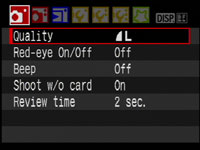 |
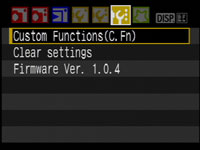 |
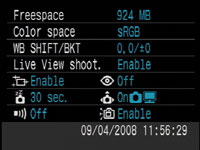 |
While the 40D has a dedicated tab for its Custom Functions, you’ll find them on the third Setup page on the 450D / XSi. There’s 13 Custom Functions in all, many of which are inherited from the 40D including Long Exposure and High ISO noise reduction and Highlight Tone Priority. Pressing the Disp button while viewing any of the menus shows a page of current settings including colour space and Live View mode.
In playback mode, pressing the Disp button cycles between a clean image, one overlaid with a little shooting information, then a thumbnail with extended shooting information and a brightness histogram, and finally a thumbnail with less shooting information, but both brightness and RGB histograms. The page with just the brightness histogram and extended shooting information can be switched to display RGB histograms instead if preferred.
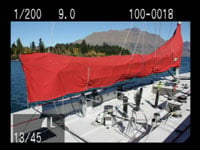 |
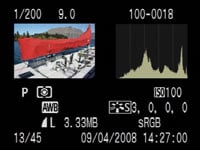 |
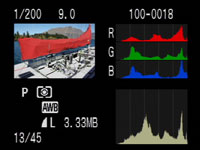 |
You can also use the magnify buttons to zoom-in on an image or zoom out to display either four or nine thumbnail views. If you’re directly connected to a PictBridge-compatible printer, the 450D / XSi also allows you to perform a number of manipulations including trimming and fine rotation, along with manual Levels adjustments.
Canon EOS 450D / Rebel XSi Battery and connectivity
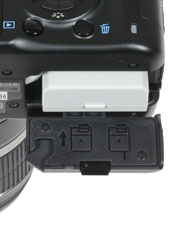 |
|
After using the same NB-2LH battery on the 350D / XT and 400D / XTi, Canon has developed a new Lithium Ion pack for the EOS 450D / XSi. The new light grey coloured LP-E5 may be roughly the same size as the earlier NB-2LH, but packs in around 50% more charge: 1080mAh to its predecessor’s 720mAh.
It’s a welcome upgrade in performance, especially now there’s a hungry Live View mode, and the pack also features sealed electrical contacts to better protect against accidental fire. Canon quotes 500 shots at 23 degrees Celsius with 50% flash usage (but no Live View) compared to the 360 shots with the 400D / XTi under the same conditions. We managed the best part of 300 shots on a single charge, although this included a lot of Live View work.
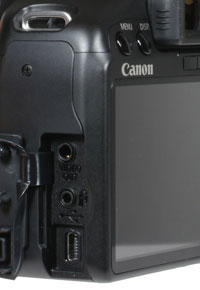 |
Sadly there’s still only four levels on the battery life indicator, compared to the accurate percentage remaining shown by Sony’s Info Lithium models. If you require longer lifespan not to mention something more to hold onto, the optional BG-E5 battery grip can take two LP-E5 packs or six AA batteries, while providing portrait controls and grip.
In terms of connectivity, a flap on the left side of the body opens to reveal the TV output, a socket for the optional RS-60E3 remote switch and a USB port. TV and USB cables are provided, and the latter can be used in conjunction with supplied software to remote trigger the camera, rendering the remote switch redundant – so long as you have a computer in close range of course.
Interestingly, Canon has made the switch from Compact Flash memory cards to SD on the 450D / XSi, and the slot can be found behind a door on the right side of the body. This makes sense as almost every other entry-level DSLR – not to mention the vast majority of compacts – use the SD format. The downside to Canon’s switch though is anyone upgrading from a 350D / XT or 400D / XTi won’t be able to use any of their spare cards or indeed their batteries either.







